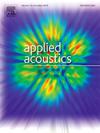The sound radiated by tip clearances submerged in a boundary layer
IF 3.4
2区 物理与天体物理
Q1 ACOUSTICS
引用次数: 0
Abstract
The present study investigates the behaviour of the far-field sound radiated by low Mach number tip clearance flow induced by placing a stationary cambered airfoil adjacent to a stationary wall. The tip clearance heights ranged from 14% to 30% of the incoming, undisturbed boundary layer thickness and the clearance heights based Reynolds numbers were between 2,600 and 16,000. The far-field sound measured using a microphone array was beamformed to reveal the dominant noise sources and how they behave when the flow Mach number, angle of attack and the clearance height were varied. The near-field behaviour was also examined through PIV measurements and surface pressure fluctuation measurements on the tip. The results show that the mid-to-high frequency noise generated by tip clearances is dominated by the leakage flow in the mid-chord and leading-edge regions, while a distinct low-frequency noise source with a different scaling behaviour exists close to the trailing-edge of the tip clearance. The origin of this low-frequency noise source is believed to be the tip separation vortex that resides close to the trailing-edge and induces significant turbulence levels in the region. The strength of this noise source decreases with clearance height which is consistent with a reduction in turbulence levels associated with the separation vortex. The magnitude of the mid-frequency clearance noise which scales with the sixth power of the Mach number, decreases with tip clearance height due to a reduction in the fluctuating pressure on the airfoil tip surface. The time-scale of this sound was independent of the flow velocity, implying that the source is non-compact. Smaller tip clearances were also found to generate louder high-frequency noise due to intense turbulence and pressure fluctuation levels concentrated near the leading-edge of the clearance.
淹没在边界层中的尖端间隙所辐射的声音
本研究调查的行为远场声辐射低马赫数尖端间隙流诱导放置一个固定的弧形翼型相邻的固定壁。叶尖间隙高度为来流未扰动边界层厚度的14% ~ 30%,基于间隙高度的雷诺数在2600 ~ 16000之间。利用传声器阵列测量远场声,通过波束形成来揭示主要噪声源及其在流动马赫数、攻角和间隙高度变化时的表现。通过PIV测量和尖端表面压力波动测量也检查了近场行为。结果表明:叶尖间隙产生的中高频噪声以中弦和前缘区域的泄漏流为主,而叶尖间隙后缘附近存在明显的低频噪声源,其标度特性不同;这种低频噪声源的来源被认为是位于靠近尾缘的叶尖分离涡,并在该区域引起显著的湍流水平。该噪声源的强度随着间隙高度的减小而减小,这与与分离涡相关的湍流水平的减小是一致的。中频间隙噪声的大小与马赫数的六次方成比例,随着叶尖间隙高度的减小,由于翼型叶尖表面波动压力的减小。这种声音的时间尺度与流速无关,表明声源是非致密的。较小的叶尖间隙还会产生更大的高频噪声,这是由于集中在间隙前缘附近的强烈湍流和压力波动水平。
本文章由计算机程序翻译,如有差异,请以英文原文为准。
求助全文
约1分钟内获得全文
求助全文
来源期刊

Applied Acoustics
物理-声学
CiteScore
7.40
自引率
11.80%
发文量
618
审稿时长
7.5 months
期刊介绍:
Since its launch in 1968, Applied Acoustics has been publishing high quality research papers providing state-of-the-art coverage of research findings for engineers and scientists involved in applications of acoustics in the widest sense.
Applied Acoustics looks not only at recent developments in the understanding of acoustics but also at ways of exploiting that understanding. The Journal aims to encourage the exchange of practical experience through publication and in so doing creates a fund of technological information that can be used for solving related problems. The presentation of information in graphical or tabular form is especially encouraged. If a report of a mathematical development is a necessary part of a paper it is important to ensure that it is there only as an integral part of a practical solution to a problem and is supported by data. Applied Acoustics encourages the exchange of practical experience in the following ways: • Complete Papers • Short Technical Notes • Review Articles; and thereby provides a wealth of technological information that can be used to solve related problems.
Manuscripts that address all fields of applications of acoustics ranging from medicine and NDT to the environment and buildings are welcome.
 求助内容:
求助内容: 应助结果提醒方式:
应助结果提醒方式:


